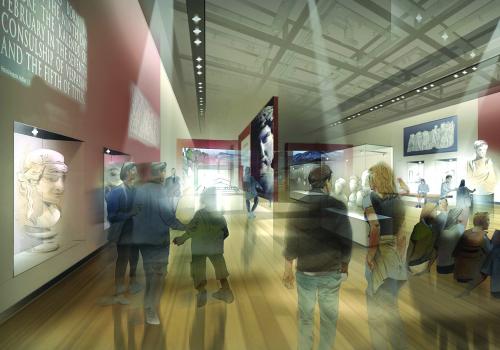Battle over British Museum extension: Objectors vow to fight on as scheme gets green light

Pictured: How the new extension will look
THE decision to allow the British Museum to build a £135 million extension must be subject to a public inquiry, furious conservation groups say.
The Camden Civic Society, along with the Bloomsbury Conservation Area Advisory Committee and a host of other architecture and historic buildings experts objected to the scheme, which was passed by Camden Council's planning committee on Thursday night.
Opponents claim the government's conservation watchdog English Heritage 'kow-towed' to the Bloomsbury institute, gave Camden Council flawed advice and have not protected a Grade-I listed building.
It was the museum's second attempt to get a new exhibition space, offices and conservation laboratories – the same committee had turned down similar plans in the summer.
The Camden Civic Society's Hero Granger-Taylor said: “We are very unhappy about the advice that Camden has received, in particular from English Heritage. Together with the Bloomsbury Conservation Area Advisory Committee we have made a second formal complaint to English Heritage about the Advice to about on both the original and revised British Museum applications.”
She added: “Together with the Bloomsbury CAAC, we shall also now be asking the Secretary of State, Department of Communities and Local Government, to 'call-in' the revised application, that is, to refer it to an inquiry.”
She added that they felt none of the reasons the original application was refused had been adequately addressed.
“The museum appears to have opted to fight a Public Relations battle,” Ms Granger-Taylor said. “Since we have no funds, and on principle are objective and accurate in our campaigning, this was a battle we were not equipped to fight.”
The meeting heard fears that the way the plans had been changed were disastrously environmentally unfriendly: to get round an issue with light being blocked into historic interiors, Lord Richard Rogers's architect practice has designed a three store, 80,000 cubic metre basement which will take around three years to build and will see 80 trucks rumbling through the streets of historic Bloomsbury to remove the spoil. The planned excavation, objectors claim, threatens the stability of its closest neighbours – a double fronted 17th century town house in Bedford Square.
Green councillor Maya De Sousa told Thursday's meeting that while she welcomed the inclusion of the green roof on one section of the new extension, adding a few beehives was a scant consolation to the enormous carbon footprint the work would cost.
Labour councillor Brian Woodward said the fact the basement also went against the council's own planning guidelines for subterranean development. He said: “If this was in Hampstead, there would be uproar.”
And the Civic Society also cried foul over what they called an underhand and well organised campaign to lobby the council. Letters were sent to the Town Hall in support of the application – and the letters pages of the New Journal – by members of staff at the museum, without declaring their interest.
Architect Dr Hugh Cullum, chair of the Bloomsbury CAAC, added: “It is very disappointing that the Committee lost the resolve it showed when, in July, it refused the original application. On Thursday evening it was misled into believing the revised proposal was a significant improvement. The British Museum acted, as one might expect, like a large corporate institution. It has steamrollered through a formulaic second-rate scheme and in the process will do great damage to its grade one listed buildings.”
Dr Cullum said: “English Heritage has been irresponsible. They should be standing up for the protection of these listed buildings. Their advice has misled the officers and thus the councillors on the real impact of the proposals. Quite apart from the damage to the listed buildings, the great tragedy is the loss of an opportunity to commission a forward looking, sensitive and considerate architectural response that works alongside the other fine buildings of the Museum.”
Museum director Neil MacGregor said the decision would secure the museum's place as one of the leading institutions of its type in the world
He said: “The Trustees are delighted. The building will ensure the British Museum can meet its fundamental obligations of preserving, researching, displaying and lending this unparalleled collection for future generations. The building will ensure the British Museum remains one of the world's leading museums, a civic space serving a local, national and international audience.”
He added work would start in January and should take around three years.
DAN CARRIER



